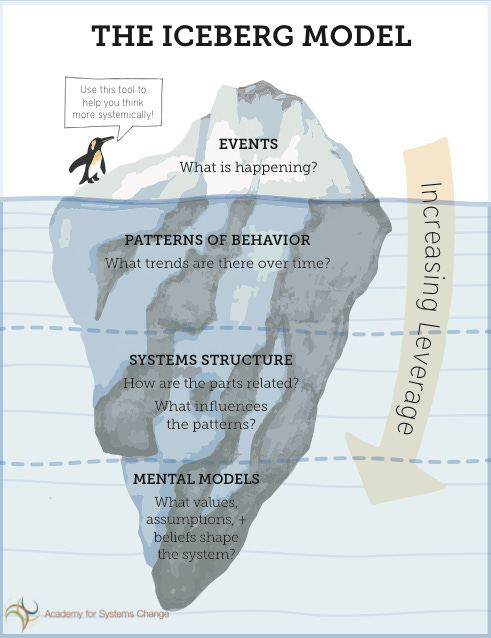Noah here. If you’ve hung around WITI for any amount of time, you’ll have noticed our fascination with systems. Many of our editions are focused on unpacking second- and third-order effects and we have specifically dug into a number of models (pace layers, five whys, Copernican principle) that offer views into how those systems operate. The focus, for me at least, is because while we spend a lot of our waking hours reading and talking about specific systems, we spend surprisingly little time unpacking what they have in common.
Donella Meadows, whose book Thinking in Systems: A Primer I’ve recommended a number of times in the past, defines a system as “an interconnected set of elements that is coherently organized in a way that achieves something.”
“For example,” she explains, “the elements of your digestive system include teeth, enzymes, stomach, and intestines. They are interrelated through the physical flow of food, and through an elegant set of regulating chemical signals. The function of this system is to break down food into its basic nutrients and to transfer those nutrients into the bloodstream (another system), while discarding unusable wastes.”
Most of the time when we are looking at systems we are asking one of two different kinds of questions. The first is around intervention: if the system isn’t operating in the way we want, we need to consider doing something about it. When COVID was on the rise in March, for example, many cities made the decision to close schools as a way to prevent spread. That was a clear intervention with the hope of changing the impact of the virus.
The second systems question we ask frequently is around forecasting: what are the knock-on effects of our interventions? In the case of canceling in-person school, there were obvious second-order effects like parents needing to be home with their children or kids of low-income households not having access to food they rely on. These effects then needed to be considered for their health outcomes. Some parents, for instance, would need to leave children with grandparents, putting them more at risk to contract COVID. And those needed to be fed back into the original thinking to understand whether the intervention could turn out to be worse than what would have happened had we let children continue to go to school. In this case, it seems like the right decision was probably made, but the point is understanding systems is hard work and, particularly when the system involves human behavior, it’s nearly impossible to model perfectly. At some point, your model has to be big and complex enough to just be reality.
Why is this interesting?
We are spending a lot of time talking about systems these days, most recently, examining and dissecting the ways racism has been built into our systems of society and government, notably the police. But what does it mean for racism to be systemic? To my mind, it’s a recognition that a specific moment of racism isn’t just an isolated act, but rather the result of a number of interconnected systems that either don’t stop it or specifically promote it. It is a suggestion that the first-order cause (the police officer with his knee on the neck of George Floyd in this instance) is actually a second-, third-, or fourth-order effect of decisions that have been made or not made. This Ta-Nehisi Coates explanation of the effects of housing discrimination gives shape to the point:
If you sought to advantage one group of Americans and disadvantage another, you could scarcely choose a more graceful method than housing discrimination. Housing determines access to transportation, green spaces, decent schools, decent food, decent jobs, and decent services. Housing affects your chances of being robbed and shot as well as your chances of being stopped and frisked. And housing discrimination is as quiet as it is deadly. It can be pursued through violence and terrorism, but it doesn't need it. Housing discrimination is hard to detect, hard to prove, and hard to prosecute. Even today most people believe that Chicago is the work of organic sorting, as opposed [to] segregationist social engineering. Housing segregation is the weapon that mortally injures, but does not bruise.
Calling it a systems problem doesn’t absolve those directly responsible—whether it’s a police officer or housing developer—but rather, it suggests that we can’t focus interventions solely at that point in the system. Donella Meadows was a big fan of the iceberg model, and while icebergs are an overused trope, I think it’s a good visualization of how to think about systemic problems:

Events are the things we see. They’re what make the news. But beneath events are patterns that are visible only if we zoom ourselves out. As Meadows explained, “If the news did a better job of putting events into historical context, we would have better behavior-level understanding, which is deeper than event-level understanding. … long term behavior provides clues to the underlying system structure. And structure is the key to understanding not just what is happening, but why.” Sitting below the events, patterns, and structures are the mental models. In this case, they include obvious racist beliefs, but also, critically, notions like meritocracy, which often act to reinforce existing power structures that lay along racial lines.
The tension right now between protestors and politicians is about where in the iceberg to aim policy interventions. Protestors, to my view, appear to be pushing for changes in “system structure” by demanding shifts in not just the way police officers interact with people of color, but also in the way they’re funded and the laws they enforce. The politicians, for the most part, seem hopeful that by dealing with the “event”—particularly punishing the “bad apple” police officers who are directly responsible for specific acts of violence—they will solve the problem. While holding individuals accountable is certainly part of the solution, the iceberg model clearly shows that in order to create more wide-scale and lasting change, you must intervene deeper in the system, just as the Black Lives Matter movement and many others before them have been advocating. The point of demands like defunding the police and changing laws/policies that are overwhelmingly aimed at policing Black and brown people, is to focus on the more deeply-rooted “systems structure” rather than just the “events” that sit at the surface. To offer just two recent illustrative examples of just how harmful these policies can be, of the 40 people arrested in Brooklyn for social distancing violations as of May 7th, 35 were Black, 4 were Hispanic, and one was white and a recent report from the New York City Civilian Complaint Board found that 65% of police misconduct complaints from NYC youth were from young men of color.
In the end, the problem with the “bad apples” argument, regardless of whether you think they spoil the bunch or not, is that apples are just the “events” of apple trees. Those trees are part of a literal ecosystem, without which there would be no fruit. If an apple tree is producing lots of bad apples you have a systems problem, not an apple problem. (NRB)
Launch of the Day:
We’ve talked in the past about empathy and aging, and to that end I was excited to see the launch of Attn: Grace today (not least of which because my wife has been working with the talented team there). They’re modernizing and destigmatizing female incontinence products, a category that is stodgy and unevolved at best. It’s also a very large market. Per Forbes on the launch, “It’s actually a disruptive opportunity with a significant market that impacts 19 Million women in the U.S. and is estimated to be a $2.5 Billion category by 2022. According to the Jeffries Report, there’s a major need for innovation in a stagnant space for the aging Baby Boomer market with the percentage of women buying bladder leakage products projected to grow by more than 30% by 2024. In fact, 92% do not buy the right (or any) products to manage the condition.” (NRB)

Quick Links:
According to Snopes, the story of Samuel Beckett giving rides to a young Andre the Giant are true, but overstated. (NRB)
Someone put together a Google Slides presentation of Black Lives Matter Brand Responses (via Anita) (NRB)
From friend of WITI Charlton McIlwain: Of course technology perpetuates racism. It was designed that way. (NRB)
Thanks for reading,
Noah (NRB) & Colin (CJN)
—
Why is this interesting? is a daily email from Noah Brier & Colin Nagy (and friends!) about interesting things. If you’ve enjoyed this edition, please consider forwarding it to a friend. If you’re reading it for the first time, consider subscribing (it’s free!).


